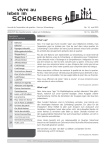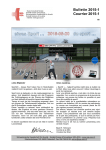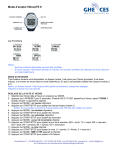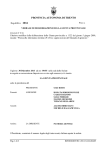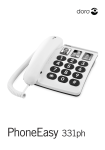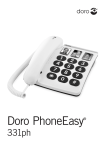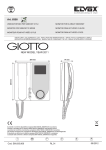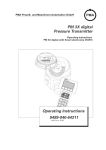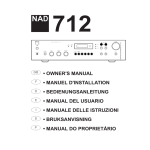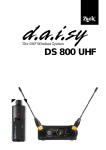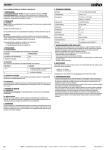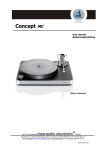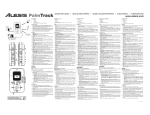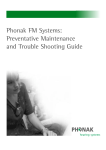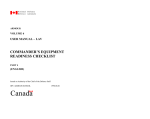Download - pro audito winterthur
Transcript
1 Rev. Siegfried Karg, B.D., Th.M. President Hard of Hearing Association of Winterthur Bolrebenweg 15, CH-8406 Winterthur / Switzerland Tel./FAX +41 52 202 09 40 Email: [email protected] To Loop or not to Loop ... Advanced Technology Induction Loop Systems for Hearing Aids and Cochlear Implants (Paper presented at the 6th International Congress of Hard of Hearing People in Sydney, Australia, July 4, 2000 and at the 19th International Congress on Education of the Deaf and 7th Asia-Pacific Congress on Deafness in Sydney, Australia, July 13, 20001, revised version) 1) Introduction: Reverberation2, background noise, and long-distance-to-the-sound source are the three main enemies of speech intelligibility for people with hearing aids and cochlear implants. To fight these enemies there are three weapons: 1) Induction Loop 2) Infrared 3) Frequency Modulation (FM). I am convinced that the Audio Frequency Induction Loop System (AFILS) is the most adequate, the psychologically least problematic, and the most cost effective technology3. Therefore I will concentrate in my paper purely on AFILS. There are certain situations in which you have to use infrared or FM, but the AFILS confirming to state-of-the-art technology is, according to my view, the basic technology for assistive listening devices. 2) The need for assistive listening devices: a) A Hearing Aid is not enough. A hearing aid or a cochlear implant is a great help to people who are hearing impaired, but it is not enough4. While communication between two persons facing each other works very well, it will become impossible in a place with strong reverberation, background noise, or long distances to the sound source (e.g. a person speaking or a loudspeaker). b) Technology does not (yet) replace our brain. With intact ears our brain can select which sound source you want to hear. When two persons talk to each other in a room where the radio is on, and a clock is ticking at the same time, our brain can partly filter out the music or the sound of the clock. Even the most advanced digital hearing aid can do this only partially or not at all. c) We need hearing aids / cochlear implants + (Plus!). In difficult hearing situations (e.g. house of worship, auditorium) there is a strong need for additional assistive listening devices in conjunction with the hearing aid or cochlear implant5. 1 The paper has been included in the Congress CD ROM Proceedings. Email: [email protected]. Kurt Eggenschwiler / Karl Baschnagel, Aktuelle Aspekte der Kirchenakustik, in: Schweizer Ingenieur und Architekt, volume 117, Nr. 25, 25 June 1999, pp. 560-564. Carsten Ruhe, Grundsätzliche Überlegungen zu Beschallungsanlagen in Kirchen und grossen Veranstaltungsräumen, Typoskipt no year, 23 pages. Carsten Ruhe, Günstige Raumakustik hilft Hörgeschädigten, in: Beratende Ingenieure 11/12 (1998), pp. 132-137. Siegfried Karg, Wider den Widerhall. Raumakustik und indukTive Höranlage, in: dezibel. Zeitschrift für Hören und Erleben 12/98, pp. 8-10. Siegfried Karg, Aktuelle Aspekte der Kirchenakustik, in: dezibel. Zeitschrift für Hören und Erleben 10/99, pp. 7-8. 3 Siegfried Karg, Gut hören ohne Pfeifen mit induktiven Schleifen. Die Position T am Hörgerät, in: dezibel. Zeitschrift für Hören und Erleben 7-8/96, pp. 24-27. Siegfried Karg, Kultur- und Kongresszentrum Luzern keine Heldentat für Hörbehinderte, in: dezibel. Zeitschrift für Hören und Erleben 7-8/2000, pp. 41-42. 4 Mark Ross, When a Hearing Aid is Not Enough: Consider other Types of Hearing Assistance Technologies (www.audiology.org/ross). 5 Alfred Sturma, Induktive Höranlagen und das CI (www.acs-akustik.at): „IndukTive Höranlagen konnten bisher nur mit Geräten des australischen Herstellers „COCHLEAR“ getestet werden. Als Tester stellten sich in dankenswerter 2 2 d) The aim of the assistive listening system is to minimize the distance to the sound source6 and to cut out reverberation and background noise. e) Although the AFILS is the oldest technique, it has been widely neglected7 until recently. A renaissance of this system worldwide is vital and I am “fighting” for it. f) In my view the AFILS has been neglected due to the following reasons: The AFILS is the cheapest system and is therefore not very profitable for the installer. You can earn much more money by installing an expensive FM-system, or an infrared system which requires special receivers for each hearing impaired person. Therefore installers are not very much interested in the AFILS. g) The AFILS is an invisible technique for an invisible impairment. Once installed nobody can see anything of the system. If a public address-system does not function, people realize it immediately because no sound comes out of the loudspeakers. If the AFILS malfunctions, only the user is affected. h) Icons which signalize the installation of this invisible technique are missing in most looped venues. In 1985 the International Federation of Hard of Hearing People (IFHOH) adopted an icon as the official symbol for AFILS. It should be used worldwide because this would allow immediate recognition. i) Most AFILS are installed incorrectly not fulfilling the standard IEC118-4 which was set by the International Electrotechnical Commission in 19818. Hard of Hearing organizations should insist that this norm should be adhered to. The customer should make a written contract with the installer, that the AFILS conforms to IEC 118-4 (since 1998 IEC 60118-4). If not, the installer should be fined. This would eliminate firms which have very little knowledge of AFILS. j) A lot of hard of hearing people know little to nothing about the function of the telecoil in the hearing aid. Even in looped areas they therefore fail to use the AFILS. k) Hearing aid manufacturers have included telecoils of different strengths9 in their hearing aids. Since the telecoil is quite large in comparison to the rest of the electronic components in the aid, smaller telecoils are included to reduce the overall size of the hearing aid. The amplification is then weaker in the T-position than in the M-position. l) In many In-the-Ear hearing aids and especially in Completely-in-the-Canal (CIC) hearing aids, there is no room for the telecoil. Because a lot of hard of hearing people consider hearing impairment as a stigma, they want “almost invisible” hearing aids. Weise Herr K. Franz Wimmer und Frau Veronika Jank zur Verfügung. Dabei zeigte sich, dass indukTive Höranlagen auch für den CI-Träger (unter Verwendung des Audioselectors) Vorteile im Hinblick auf Sprachverständlichkeit und Nebengeräuschfreiheit bringen. Frau Jank war es möglich, problemlos Sendungen im Fernsehen zu verfolgen. Herr Wimmer konnte sich u.a. in der Auferstehungskirche in Wien von der einwandfreien Funktion einer indukTiven Höranlage überzeugen. Aussage des Herrn Wimmer: ‚Ich habe noch nie so gut verstanden wie mit dieser Anlage!‘“ 6 The Swiss hearing aid company PHONAK mentions on its website that with a hearing aid you have problems with reverberation already at a distance greater than 2 meters and therefore suggests their wireless FM-system “MicroLink” as a possible solution to the problem. 7 This is especially true for the USA. „IL systems are the oldest - and least employed - of the existing ALS in this country (they are used much more often in European countries).” Matthew H. Bakke, Harry Levitt, Mark Ross, Faye Erickson, Large Area Assistive Listening Systems: Review and Recommendations, Final Report to United States Architectural and Transportation Barriers Compliance Board (U.S. Access Board), Lexington School for the Deaf / Center for the Deaf, Jackson Heights, NY. December 1999, p. 3 (quoted from: www.hearingresearch.org) 8 International Electrotechnical Commission, IEC Standard 118-4. Methods of measurement of electro-acoustical characteristics of hearing aids. Part 4: Magnetic field strength in audio-frequency induction loops for hearing aid purposes, Geneva 1981. Ingenieur Alfred Sturma (Vienna, Austria) informed me that the standard was reworked by the International Electrotechnical Commission in 1998. The new standard is EN 60118-4. 9 The hearing aid manufacturer Siemens explicitely mentions the strength of the telecoil for their different models. Siemens. Handbuch HdO-Geräte: „Hörspulenempfindlichkeit bei 1,6 kHz [re 20 Pa (1 mA/m)].“ 3 m) As far as I know, until now only two manufacturers of cochlear implants “COCHLEAR” and “ADVANCED BIONICS”10 produce speech processors with a telecoil11 up to now. I urgently advise the other manufacturers12 to do the same, because reverberation, background noise, and long distances to the sound source are even greater problems with the CI13 than with the hearing aid. 3) Personal experience: 30 years ago I met a hard of hearing person for the first time. At that time my fiancée was staying with her aunt, who has been hard of hearing since childhood. This aunt could never understand me on the telephone. I tried to speak louder but that only made things even worse. Someone told me that you could get a special phone with inductive coupling. With this phone you could use the telecoil of the hearing aid. Finally the aunt got such a phone, and since that time she can understand me perfectly on the phone. For me this experience was the key for my activism in favour of audio frequency induction loop systems. 4) History: AFILS is a technology which has been known since the thirties14 or forties15. The system became less popular when infrared systems and FM-systems appeared. These systems however require a special receiver. For the induction loop system, on the other hand, you only have to switch your hearing aid from microphone (M) to telecoil (T), allowing you to use the individual amplification of your personal hearing aid. There is a renaissance of AFILS in Europe and also in the USA16. Hard of hearing people and cochlear implant users realize the many advantages of this system. In my view it is especially 10 I sent a questionnaire in May 2000 to the following manufacturers: Cochlear, Advanced Bionics, MED-EL. Cochlear and Advanced Bionics responded. 11 At the ICED2000 congress I had the privilege to visit Cochlear Limited in Lane Cove (Sydney), where the Cochlear cochlear implants are produced, and talk to the engineers. They are considering to integrate the telecoil even in the tiny ESPritTM 22 Ear Level Speech Processor for Nucleus® 22 recipients. Up to now the telecoil is an accessory for cochlear implants. 12 At the ICED2000 congress I talked to Mr. Douglas Clutton from MED-EL. In the meantime (August 16, 2000) I got an email from Mr. Stefan Sroka from MED-EL telling me the following: “I want to inform you that we are currently working on an assistive listening device (ALD) for our TEMPO+ behind-the-ear speech processor. This device will contain an active telecoil to enable the users of the TEMPO+ to couple to loop systems. This ALD will comply to IEC 60118-1 and can be connected to the external audio input of the speech processor. ... Our ALD will come up during this year.” 13 Beverly Biderman, Wired for Sound. A Journey into Hearing, Toronto: Trifolium Books 1998, p. 11: “The range between the softest and loudest sounds I can hear with my implant is less than one-fifth of the range of a normal hearing person, and therefore my ability to make fine distinctions between signal and noise or foreground and background is poor. This is why background noise is so difficult for most people who wear a cochlear implant.” 14 Paula Hendricks & Norman Lederman, Looping the World: Re-discovering a simple and effective hearing assistance system, Part I: Induction loop basics, history and advancements (www.ovalwindowaudio.com): „The first portable hearing aid to incorporate a telecoil was the Multitone Model VPM in 1938, following an early patent for an IL hearing assistance system by Joseph Poliakoff of Great Brtain in 1937. Interestingly, IL systems were used in Europe long before becoming available in the USA, making its first appearance as an imported product after World War II.“ 15 David A. Preves, A Look at the Telecoil - Its Development and Potential, in: SHHH Journal, September/October 1994, p. 7: „In 1947, Samuel Lybarger, then chief engineer at the Radioear hearing aid company, discovered that when people used telephones, magnetic energy leaked out from the receiver in the telephone handset. Even more significantly, he also found that this magnetic leakage could be useful to people with hearing loss if it was picked up with a small coil in the hearing aid (Lybarger, 1947)." 16 In the USA you have the Americans with Disabilities Act (ADA) since 1990. The Accessibility and Transportation Board has issued “Accessibility Guidelines for Buildings and Facilities” (amended through January 1998). Under the section “Accessible Buildings: New construction” you find at point (19) Assembly areas: “(b) This paragraph applies to assembly areas where audible communications are integral to the use of the space (e.g. concert 4 suitable for countries where money is scarce because this is the cheapest technology of assistive listening devices. 5) Design of systems where spillover is no problem: 1. Priority: The loop is placed alongside the walls of the room at floor level or up to 40 cm below floor level. 2. Priority: If it is not possible to place the loop at floor level, the loop can also be placed along the edges of the ceiling, if the room is not too high. For a ceiling loop however much more amplification is needed than for the floor loop. The wire of the loop should be placed in a standard plastic pipe used for standard electrical installations. If the plastic pipe is put in a new building before the building is finished, the costs are almost nil. Therefore, AFILS should be planned early. The plastic pipe should contain only the loop wire and no other electrical wires, because every wire in which electricity flows, produces a magnetic field. This field will be picked up and amplified by the induction loop system producing a disturbing hum. Other electrical wires should not be put parallel to the loop or within a distance of at least 20 cm. Electrical wires crossing the loop wire do not cause any harm. No high voltage wires should cross the loop area, because this produces additional disturbing hum. Already in the planning process the person planning the high voltage system should be in close contact with those responsible for the AFILS and the normal electrical wiring. If they communicate well a lot of irrevocable mistakes could be avoided. In larger assembly areas with fixed seats (e.g. houses of worship) where there is an aisle in the middle of the room, a loop design like a figure 8 could be planned. If this is done the direction of the current must go in the same direction in the aisle area, because opposite directions will “kill” the magnetic field. After installation, the loop driver has to be adjusted correctly conforming to standard IEC 118-4 (IEC 60118-4). Magnetic field strength and also frequency response should be measured. 6) Voltage versus current: In former times the same amplifier that was used for the public address system was used as a driver for the induction loop. This actually works. But AFILS based on voltage perform poorly in the high frequencies which are so important for speech intelligibility17. The impedance of the loop wire increases with the high frequencies. Therefore the amplifier has to furnish more current. The audio amplifier based on voltage cannot produce a current which is independent of the frequency18. and lecture halls, playhouses and movie theaters, meeting rooms, etc.). Such assembly areas, if (1) they accommodate at least 50 persons, or if they have audio-amplification systems, and (2) they have fixed seating, shall have a permanently installed assistive listening system complying with 4.33. For other assembly areas, a permanently installed assistive listening system, or an adequate number of electrical outlets or other supplementary wiring necessary to support a portable assistive listening system shall be provided. The minimum number of receivers to be provided shall be equal to 4 percent of the total number of seats, but in no case less than two. Signage complying with applicable provisions of 4.30 shall be installed to notify patrons of the availability of a listening system.” “4.33.7 Types of Listening Systems. Assistive listening systems (ALS) are intended to augment standard public address and audio systems by providing signals which can be received directly by persons with special receivers or their own hearing aids and which eliminate or filter background noise. The type of assistive listening system appropriate for a particular application depends on the characteristics of the setting, the nature of the program, and the intended audience. Magnetic induction loops, infra-red and radio frequency systems are types of listening systems which are appropriate for various applications.” 17 Beverly Biderman, Wired for Sound. A Journey into Hearing, Toronto: Trifolium Books 1998, p. 12: “Treble sounds give 95% of the information used in understanding speech. Bass sounds, while they account for 95% of the volume of speech, provide only 5% of the information used for comprehension.” 18 Siegfried Karg, Wider den Widerhall. Raumakustik und indukTive Höranlage, in: dezibel. Zeitschrift für Hören und Erleben 12/98, p. 9. 5 Advanced technology induction loop drivers using current instead of voltage perform well even in the high frequencies. Therefore the quality of the sound and the speech intelligibility is much better. In new buildings and in renovated buildings only induction loop drivers based on current should be used (e.g. Ampetronic19 [United Kingdom] , Univox by Bo Edin AB [Sweden] , Logia / Oticon Lydsystemer AS [Denmark]). 7) Low spillover systems: Normal induction loop systems produce a certain “spillover” of the magnetic field20. This could be awkward in adjacent rooms (e.g. classrooms, cinemas). Up to now this problem prevented installation in such rooms. This problem has now been addressed: a) 3-D-Loop System of Oval Window Audio, USA: The US manufacturer of AFILS Oval Window Audio in Nederland, Colorado has developed a so called 3-D-loop system with little or no spillover.21 b) Phase Array System of Ampetronic Ltd., United Kingdom The English firm Ampetronic has now developed a system, which limits the spillover of the magnetic field very much so that it is now possible to have AFILS even in rooms next to each other22. You need a certain loop design which Ampetronic simulates for you on their computer according to the measurements of your room. A special phase shifter is also needed. Often there is an additional need for metal loss correction23. 8) The situation in Europe and in the USA: Let me mention just some examples: 19 At a wedding in the old monastery church „Paradise“ in Langwiesen / Switzerland on June 10, 2000, where I had installed a mobile induction loop using the Ampetronic ILD 252 induction loop driver, Kurt Wirth (Zürich), who wears a Cochlear cochlear implant with a telecoil as accessory was very much impressed about the speech intelligibility on the induction loop. 20 Norman Lederman, Selecting a Loop System (www.ovalwindowaudio.com): „All conventional loop systems exhibit signal „spill over“, or „bleeding“ outside the loop wire. This means that adjacent rooms (in the vertical as well as horizontal plane) cannot have loop systems operating at the same time without interfering with each other.“ 21 Paula Hendricks and Norman Lederman, Development of a three-dimensional induction assistive listening system, in: Hearing Instruments vol. 42, No 9, 1991. Norman Lederman and Paula Hendricks, Induction Loop Assistive Listening Systems, in: Communication Access for Persons with Hearing Loss. Compliance with the Americans with Disabilities Act, ed. by Mark Ross, Baltimore, Toronto Sydney: York Press 1994, pp. 19-39. 22 Ampetronic Information Sheet, Induction Loops Their Purpose & Functions, p. 4: „Audio-Frequency Induction Loops create a magnetic field which is not constrained to the area of the loop installation. Normal systems using a perimeter loop create spillover so that they are clearly audible some 3 to 4 loop sizes away. There are many instances where this is unacceptable, such as in multiscreen cinema complexes, conference room situations, council chambers, multiple common rooms in sheltered house, etc. AMPETRONIC have developed various technologies to minimise the loop spillover such that the above-mentioned situations can be easily resolved. Typically, in multi-screen cinemas we can provide a large portion of the seating in each auditorium with full quality sound while keeping the crosstalk from adjacent cinemas more than 40 db below the normal signal for all the seats in the auditorium, ensuring compliance with film classification regulations. This is also applicable to conference rooms. Additional techniques can be used to create secure systems, where absolute secrecy is vital.” (www.ampetronic.com). 23 Ampetronic Information Sheet, Induction Loops Their Purpose & Functions, p. 18: “A serious problem in modern buildings is the presence of large amounts of metal in the floor and/or ceiling of the buildings. This metal causes a frequency-dependent loss of magnetic field. The actual loss can be up to 3db per octave, with a lower corner frequency between 0.1 Hz and 100 Hz. This loss equals 15dB change from 150Hz to 5kHz! There is no simple solution, but the MLC 9 (Metal Loss Corrector) permits the frequency response to be levelled, being fully adjustable from 0 to 3db per octave.“ 6 a) Denmark: Practically all churches are equipped with an excellent AFILS24. The governing body responsible for churches issued recommendations for AFILS25 as early as March 1986. The loop system will be checked every year to see if it still meets the standards. b) Norway: In the year 1993 the church council issued a publication on AFILS which was sent to all churches.26 c) Sweden: In Sweden the Nordic Committee on Disability has issued “Requirement specification for hearing aids”27. The telecoil is an integral part of it. d) Great Britain: There a special Code of Practice for AFILS exists.28 “Loop systems in public buildings must be installed to British Standard Code of Practice for Audio Frequency Induction Loop Systems BS 7594. If you quote this code of practice in all specifications and contracts, it should help to ensure that your induction loop system is designed and installed to professional standards, works properly, is safe, and meets regulations.”29 e) Austria: There are not many AFILS that meet the standard. According to an official regulation effective in 1991, every audiologist should have an induction loop system to check the inductive coupling of the hearing aid.30 According to the president of the Austrian Union for Hard of Hearing People (ÖSB), Hans Neuhold, very few have such a system. Since 1997 there has been a fantastic renaissance of AFILS in Austria, starting with the installation of a new AFILS in the Church of the Resurrection in Vienna.31 f) Switzerland: All public telephone booths have inductive couplers. Most train stations32 have at least one ticket corner with AFILS. In most churches33 there are AFILS. Many of them do not 24 Oticon Lydsystemer A/S, Teleslynge- og højttaleranlæg. Cirkulæere om trådløse høreanlæg i kirkerne, 21. marts 1986 (www.churchear.org) 26 Kirkekonsulenten informerer 1-1993, Teleslyngeanlegg i KIRKEBYGG. Krav til teleslyngeanlegg. In 1998 the church council published the following brochure: „Gjør døren høy, gjør porten vid...!“ Om tilrettelegging for funksjonshemmede i menighetene, Oslo 1998. 27 Nordiska Nämnden för Handikappfrågor (Nordic Committee on Disability), “Requirement specification for hearing aids”4th edition, 1994-10-26. 3.3.5 Induction pick-up coil: “The hearing aid shall have an induction pick-up coil. In a vertical magnetic field as described in the IEC 118-1 the sensitivity of the pick-up coil shall not increase more than 2 dB when the hearing aid is tilted in any direction from the position as worn on a head-and-torso simulator (IEC 959, Provisional head and torso simulator for acoustic measurement on air conduction hearing aids) tilted 10° forward. ... Note: In some cases, eg owing to small size, a hearing aid without an induction pick-up coil may be accepted.” 4.7 Induction pick-up coil „An inductive input signal of 31.6 mA/m shall give the same output signal level as an acoustical input signal (using the M-position) of 57 -67 dB SPL in the frequency range 1000 - 4000 Hz and of 55 - 67 dB SPL in the range 500 up to 1000 Hz. This requirement applies for both T- and MT-positions and for any setting of the tone controls of the hearing aid. When switching between control positions T and MT the sensitivity of the induction pick-up coil shall not change more than 2 dB in the frequency range 500 to 4000 Hz.” 28 British Standard Code of Practice for Audio Frequency Induction Loop Systems (AFILS) BS 7594, 1993. 29 RNID Factsheet, Induction loops and infrared in public buildings (www.rnid.org.uk) 30 676. Verordnung des Bundesministers für wirtschaftliche Angelegenheiten, mit der die Verordnung über Ausübungsvorschriften für das gebundene Gewerbe der Hörgeräteakustiker geändert wird. ... Er muss mindestens ausgestattet sein mit ... g) einer elektrischen Ringleitung oder einer gleichwertigen technischen Einrichtung zur Überprüfung der induktiven Übertragungseinrichtungen.“ 31 Siegfried Karg, Fachgutachten zu Handen des Oberkirchenrats betreffend kombiniertes Lautsprecher- und Schwerhörigensystem in der Auferstehungskirche Wien, Lindengasse 44a, 1997, 8 Seiten. Alfred Sturma, Induktive Höranlagen. Aufbau und Funktion. Ein kurzer Leitfaden für Anwender und Hörgerätebenutzer, Wien 1997. Since 1999 there is a „Checkliste für IndukTive Höranlagen. Ein Ratgeber für Unternehmen und Institutionen, herausgegeben von der Arbeitsgemeinschaft österreichischer Schwerhörigenvereine." Hans Neuhold, Unerhört. Erhebung hörbehindertengerechter Ausstattungen in öffentlichen, kulturellen, sozialen und allgemein zugänglichen Einrichtungen und Betrieben in der Stadt Graz, Graz 1999. 32 Oskar Ulrich, Hallo! Wo seid Ihr Hörbehinderten?, in: dezibel. Zeitschrift für Hören und Erleben 11/96, p. 2. Schweizerische Bundesbahnen, Informationen für behinderte Reisende. 33 Siegfried Karg, Nichts verstanden? Tipps für Hörgeräteträger in Kirchen und Vortragssälen mit induktiven Höranlagen (Ringleitungen), 1998. 25 7 meet IEC-standard 118-4 (60118-4) and are driven by voltage amplifiers instead of specific induction loop drivers using current. There has been an upsurge in the last years34 and there are many positive examples such as a tour bus35 in Winterthur or the United Bank of Switzerland (UBS) in Winterthur where two desks have been equipped with induction loop systems. g) Germany. Not many AFILS36 exist and those are mostly not conforming to EN 60118-437. The German Hard of Hearing Union (Deutscher Schwerhörigenbund) has published a brochure claiming that AFILS were “old fashioned”38. h) USA. There is a small renaissance of AFILS. The main problem is that, according to Mark Ross, only thirty percent of the hearing aids in the USA are equipped with a telecoil. Self Help for Hard of Hearing People supports telecoils in a position statement:39 ”SHHH recommends that all hearing aid dispensers inform their patients of the function and potential advantages of “T” coils during the course of the hearing aid selection process, and, further, strongly suggests their inclusion in the hearing aids.” SHHH and the Johns Hopkins Center for Hearing and Balance have also produced a video film on the same subject: The Telecoil: Plugging into Sound40. 9) Technical Recommendations: a) Use only single loop cable. b) The diameter of the loop cable (0.5 mm2, 0.75 mm2, 1 mm2, 1.5 mm2, 2.5 mm2) has to be calculated according to the dimensions of the room. c) A special induction loop driver using current and not voltage has to be used for the loop. You may pick up the signal from a separate microphone or from one which is already being used for the public address system. d) After correct installation of the loop, the system has to be adjusted properly through a qualified person measuring the field strength and also the frequency response. Once the system is correctly adjusted, there is normally no need for readjustment. e) The person responsible for the room should be instructed properly. A written user’s manual should be handed out in which the location of the loop cable, its diameter and the measuring sheet should be included. f) The international IFHOH icon (accepted in 1985) should be placed at the entrance of the room so that it is clearly visible to everybody that an AFILS is installed. 34 Walter Buchs / Gregor Schafer, Höranlagen in Kirchen und öffentlichen Sälen. Leitfaden für Besteller und Bedienungspersonal, Wünnewil: Hörbehindertenverein Deutschfreiburg 1998. Induktives Hören mit dem Hörgerät. Eine Gebrauchsanleitung für Hörgeräteträgerinnen und Hörgeräteträger. Mit einem Verzeichnis der Höranlagen in öffentlichen Gebäuden im Kanton Bern und in Deutsch-Freiburg, Bern: pro audito Schwerhörigen-Verein Region Bern no year. 35 Siegfried Karg, Reisecar mit induktiver Höranlage, in: dezibel. Zeitschrift für Hören und Erleben 3/96, pp. 20-21. 36 Ruth Müller, Machen Sie mit: „Audio-Watching“ .....????, in: DSB-Report 1/98. 37 Merkblatt zum Einbau von Höranlagen für Schwerhörige in Kirchen und Versammlungsräumen, hrsg. von der “AFESS - Arbeitsgemeinschaft für Evangelische Schwerhörigenseelsorge e.V.” in Verbindung mit dem “Deutschen Schwerhörigenbund e.V.” (Text: P. Drews und Arbeitsgruppe an der Schwerhörigenschule Hamburg), no year: „Der Verstärkerausgang wird über einen Transformator unmittelbar mit der den Raum umgebenden Induktionsschleife verbunden.“ Kurt Eggenschwiler / Karl Baschnagel, Aktuelle Aspekte der Kirchenakustik, in: Schweizer Ingenieur und Architekt, volume 117, Nr. 25, 25 June 1999, p. 563: “Der weit verbreitete Schleifentrafo hat heute ausgedient. Ein ausgeglichener Klang, vor allem in den hohen, für die Sprachverständlichkeit wichtigen Frequenzen kann nur erreicht werden, wenn das Sprachsignal mit einem Stromverstärker mit AGC (Automatic Gain Control) mit Bandpassfilter und einer allfälligen Kompensationsmöglichkeit der Armierungseisenverluste in die Induktionsschleife eingespeist wird.” 38 Deutscher Schwerhörigenbund, DSB-Ratgeber 4: Technische Hilfen für Hörgeschädigte, Berlin: DSB 1996: „Induktionsanlagen. Sie entsprechen nicht mehr dem heutigen Standard, sind sehr störanfällig, können auch in der Lautstärke nicht individuell reguliert werden, sind jedoch in vielen Versammlungsräumen und Kirchen installiert und kommen aus Kostengründen immer noch häufig zum Einsatz.“ 39 Self Help for Hard of Hearing People, Inc., Position Statement on Telecoils, in: Hearing Loss September/October 1996, pp. 29-30. 40 10-minute video available from Self Help for Hard of Hearing People, Inc., Bethesda, MD, USA. 8 g) If it is not possible to install the loop in the whole room, a drawing should show which part of the room is looped. h) A sign should remind people where the loop wire is installed (e.g. under the carpet) so that it will not be harmed if, e.g., a hole has to be driven in the floor for another installation purpose. 10) Recommendations for Hard of Hearing People and CI people a) Accept only hearing aids41 or cochlear implants with a (strong) telecoil42 from your dispenser. This has nothing to do with costs. The telecoil is extremely cheap compared to the hearing aid or CI (about 2% of the cost of a hearing aid). This eliminates Completely in the Canal (CIC) hearing aids (although Bill Clinton wears them!) because there is not enough space to include a telecoil. If you have a small ear canal this even eliminates In-the-Ear(IO) hearing aids because of lack of space. Well designed (Porsche design?) Behind-The-Ear hearing aids with strong telecoils are the future!43 b) Hard of Hearing People and Hard of Hearing Organizations should put pressure on hearing aid and CI manufacturers to encourage them to only produce hearing aids and CIs with telecoils. c) In countries where hearing aids are financed by an organization (impairment insurance of the state, e.g. Switzerland for men below the age of 65 and women below the age of 63) the organization should subsidize only hearing aids or CIs in which a telecoil is included. If someone wants a hearing aid without a telecoil, he or she can get it on the free market but then should pay the full price himself or herself. In Sweden only hearing aids with telecoils are subsidized by the state. I think this leads into the right direction. d) In a room with more than 50 seats always ask for an AFILS. Handicapped persons in wheel chairs get their ramps44 and lifts even if only one handicapped person has to use it. e) Don’t forget to keep your head upright in a venue with an AFILS. If you fall asleep the telecoil is no longer in an upright position and you will not get the advantage of it anymore. D:\schwerhö\LOOP007\31.10.2000\Karg 41 Siegfried Karg, „Wie hast du’s mit der IndukTion?“ Die „Gretchenfrage“ bei der Anschaffung eines Hörgeräts. Orientierungshilfe für Konsumenten, Winterthur: Schwerhörigen-Verein 1998, 16 pages (WINFO(H)RMATIV Nr. 1. Informationsschriften des Schwerhörigen-Vereins Winterthur). 42 Siemens, Signia. Behind-the-Ear Instruments. Operating Instructions: „The middle position T is intended for telephoning and for using inductive loops, e.g. in churches, theatres or lecture rooms. Using the T position for telephoning requires that the telephone is suitable for hearing instruments and emits a corresponding magnetic field. Unfortunately not all modern telephones, especially cordless telephones and mobile phones, produce a magnetic field.“ 43 Siegfried Karg, Die unsichtbare Behinderung - sichtbar gemacht, in: dezibel. Zeitschrift für Hören und Erleben 3/97, pp. 4-7. Siegfried Karg, See how well I can hear!, in: IFHOH Journal Volume 20 # 1, February 1999, pp. 1013. 44 Jan Grønborg-Eriksen, A Ramp is not enough - Accessibility of Houses of Worship, SHHH panel, Boston, 14.6.98 (www.churchear.org).










